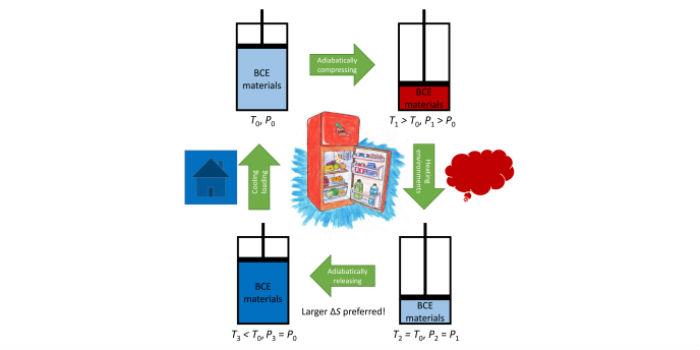 International. Phase transitions are performed with heat (i.e., entropy) exchanged between materials and environments. When such processes are pressure-driven, the induced cooling effect is called the barocaloric effect, which is a promising alternative to the conventional vapor compression cycle. For the purpose of actual application, it is desirable for a material to have greater entropy changes induced by a smaller pressure.
International. Phase transitions are performed with heat (i.e., entropy) exchanged between materials and environments. When such processes are pressure-driven, the induced cooling effect is called the barocaloric effect, which is a promising alternative to the conventional vapor compression cycle. For the purpose of actual application, it is desirable for a material to have greater entropy changes induced by a smaller pressure.
Recently, an international research team led by Prof. LI Bing of the Metals Research Institute of the Chinese Academy of Sciences discovered that a class of disordered materials, called plastic crystals, exhibit large barocaloric effects under very weak pressure. Typical entropy changes are several hundred joules per kilogram per kelvin, which is ten times better than previous materials.
Accessing large-scale facilities in Japan (J-PARC and SPring-8) and Australia (ANSTO) to use neutron scattering and synchrotron X-ray diffraction techniques, the team revealed that the constituent molecules of these materials are widely disorganized in the orientation of networks and these materials are inherently very deformable. As a result, a small amount of pressure is able to suppress the extensive orientation disorder to induce phase transitions to the ordered state and thus huge pressure-induced entropy changes are obtained. These two merits make plastic crystals the best barocaloric materials so far.
This research is the first report that entropy changes can exceed one hundred joules per kilogram per kelvin. It represents the best results among all the materials of caloric effect (barocaloric effect as well as its analogies, such as the magnetocaloric effect, the electrocaloric effect and the elastocaloric effect), considered as a milestone. The microscopic physical scenario established by the neutron scattering technique is useful for designing even better materials in the future.
As far as the refrigeration application is concerned, the plastic crystals reported here are very promising, given that they are available in abundance, are environmentally friendly, easy to handle and high performance. This work points in a new direction for emerging solid-state cooling technologies.
Source: Chinese Academy of Sciences.














